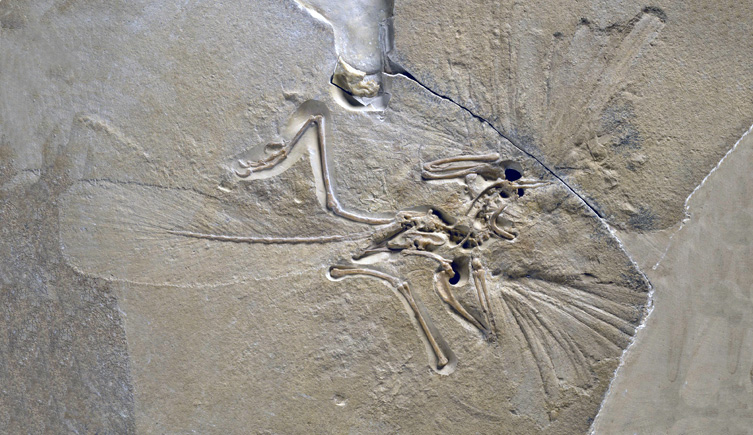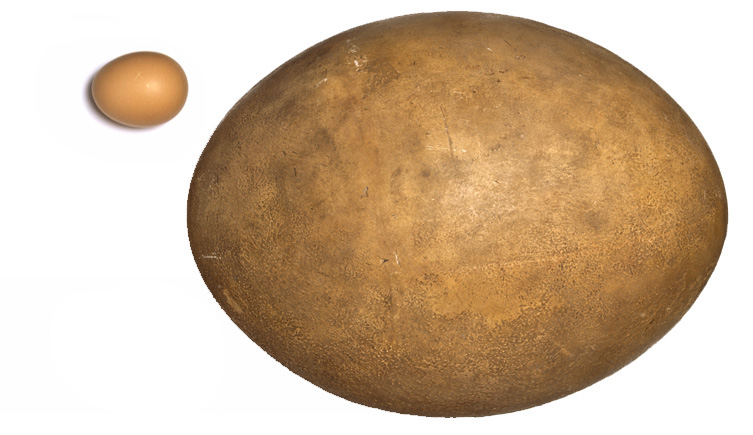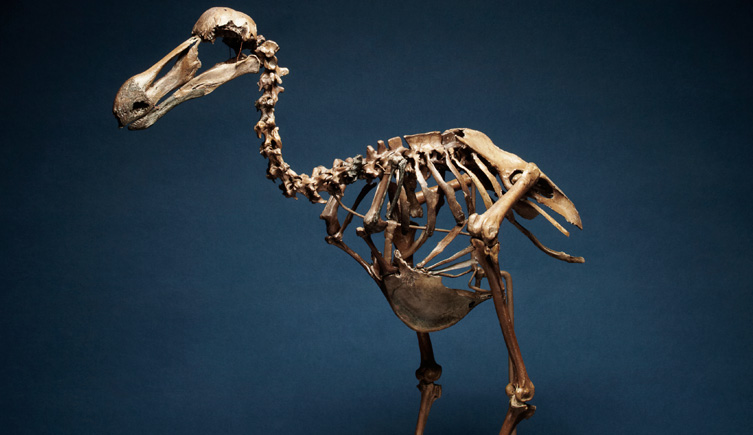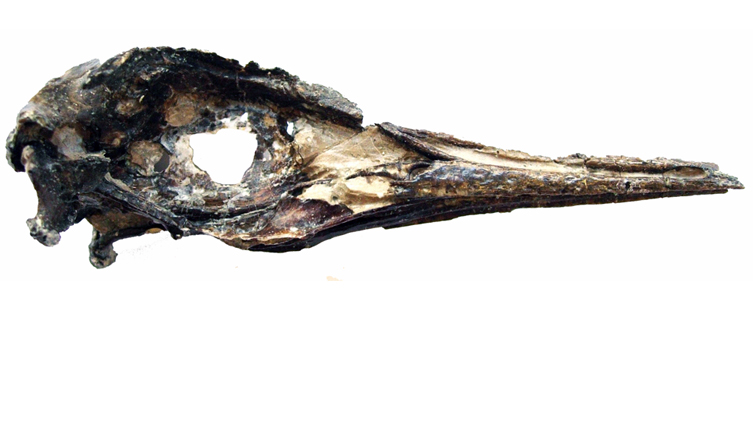
Skeleton of the extinct Raphus cucullatus (dodo). Collected during the 1860s from the Mascarene Islands in the Indian Ocean.
The fossil bird collection includes Archaeopteryx, large flightless birds (ratites) and recently extinct species such as the dodo.
Collection strengths
Archaeopteryx
The Museum’s specimen of Archaeopteryx lithographica originates from the latest Jurassic Solnhofen Limestone in Bavaria, Germany. It was among more than 1,900 Solnhofen fossils bought from Dr Karl Haberlein in 1862 for £700.
Archaeopteryx shows a unique combination of dinosaur and bird characters. It is one of the few fossils that actually show evolution in action and the transition between 2 major groups of animals.
Ratites
Ratite material in the Museum’s fossil bird collection:
- A very large collection of moas from New Zealand, including several type specimens and the original fragment of long bone that allowed Richard Owen to deduce the existence of these large extinct flightless birds. The bone was discovered between 1831 and 1836 on the east coast of North Island, New Zealand and was brought to Owen in 1839.
- Skeletal remains and 12 unbroken eggs of the elephant bird, Aepyornis, from Madagascar.
Owen's statue at the Museum shows him holding the moa bone fragment, and one of the elephant bird eggs is on display in the Bird Gallery.
The collection also contains older fossil bird specimens from the Eocene, Miocene and Pleistocene.
Looking for a specimen?
The fossil bird collection is being digitised
Curators
Any questions ?
If you would like to use any specimens for research
Major collections
Cenozoic birds
In addition to recently extinct species, like moas and elephant birds the Museum also cares for older fossil bird specimens from the Eocene, Miocene and Pleistocene.
Eocene
The Lower Eocene exposures on the Isle of Sheppey have yielded material from several birds, including the so-called bony-toothed bird, Odontopteryx, and Prophaethon, a relative of the tropicbirds.
The fossil bird collection includes a wide range of taxa from Upper Eocene and Lower Miocene localities in France.
Phorusrhachids from Patagonia were donated as part of the Ameghino Collection in 1896.
Pleistocene
Pleistocene material represents more than half of the fossil bird collection. Significant material includes:
- the Forbes Collection from 1892 and the Walter Rothschild Collection from 1900, which contain thousands of individual bones and some complete skeletons of flightless rails and ostrich coots from Chatham Island, New Zealand.
- two complete skeletons of the dodo, Raphus cucullatus, an endemic flightless pigeon from Mauritius. One is on display in the Hintze Hall
- extensive material of the solitaire, Pezophaps solitarius, from Rodrigues Island in the Indian Ocean, another extinct bird closely related to the dodo
- material collected by Dorothea Bate from Mediterranean islands, especially Malta, and Tabun in Palestine
- large holdings of material from Gibraltar and West Runton in Norfolk
-

Specimen of the early bird Archaeopteryx lithographica at the Natural History Museum, London, showing both dinosaur and bird features
-

Elephant bird eggs are the largest known bird eggs. One is shown here next to a hen egg for comparison. Elephant birds are extinct and were last seen around 1650.
-

Skeleton of the extinct Raphus cucullatus (dodo). Collected during the 1860s from the Mascarene Islands in the Indian Ocean.
-

Skull fossil of Prophaethon, an extinct genus of seabird that lived during the early Eocene
Country of origin
Countries mentioned: Germany, New Zealand, Madagascar, Mauritius, Rodrigues Island, Mediterranean (especially Malta and Tabun in Palestine ), Gibraltar, England (West Runton in Norfolk).
Geological range
- Late Jurassic to Pleistocene
Important collectors
- Richard Owen
- Forbes Collection (1892)
- Walter Rothschild Collection (1900)
- Dorothea Bate

Collections on the move
Access to some collections will be affected as we prepare for the move to our new collections, science and digitisation centre.

Accessing the collections
Scientists and collections management specialists can visit the collections and borrow specimens for research.

Collections management
Our duty is to provide a safe and secure environment for all of our collections.